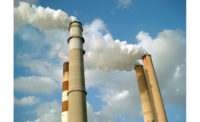States, Utilities Take Sides on Carbon Emissions Regulations

A federal appeals court on Sept. 17 dismissed a set of lawsuits challenging the Obama administration’s Clean Power Plan, a policy aimed at cutting greenhouse gas emissions from power plants, especially coal-fired plants. The lawsuits were moot after the Trump administration replaced the regulation with the Affordable Clean Energy Rule, said the U.S. Court of Appeals for the District of Columbia Circuit, but that rule, which is more industry friendly, now faces its own set of challenges.
A number of large public and private electric and gas utilities together asked the appeals court to overturn the Environmental Protection Agency’s ACE rule and review its repeal of the Obama administration’s Clean Power Plan. The ACE rule will result in more pollution and higher costs for industry and customers, a group called the Power Companies Climate Coalition said in a Sept. 6 statement.
The ACE rule sets guidelines for greenhouse gas emissions from existing coal-fired units and details how states should establish performance standards for certain greenhouse gas emissions for power plants. But it prohibits the power sector from using more effective emission reduction measures, such as emission trading and adding generation from lower-emitting sources, the group said.
Members of the coalition include Consolidated Edison, Exelon and National Grid. Con Edison said the new rule would undermine its efforts to achieve a meaningful reduction in greenhouse gas emissions, including 2,600 MW of renewable generation it has in 17 states.
Twenty-two states filed a similar petition asking the court to throw out the ACE rule. Another 21 states intervened in the states’ lawsuit, backing the ACE rule and saying they “strongly support EPA’s return to the principles of cooperative federalism.”
The International Brotherhood of Electrical Workers also stepped in to support EPA’s actions, saying its members would face loss of jobs, wages and other benefits from the premature retirement of many affected coal-fired electric generating units under the Clean Power Plan.



